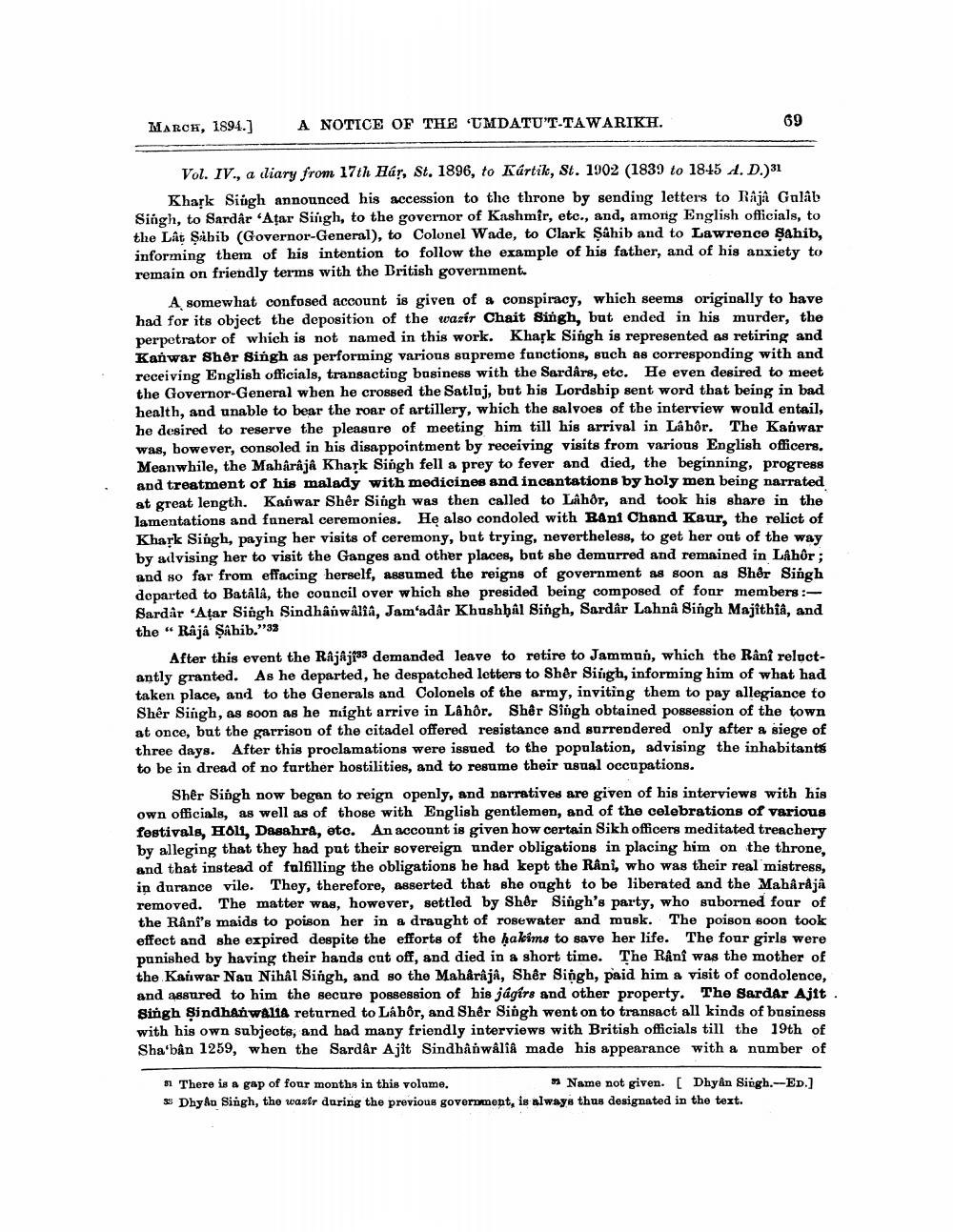________________
MARCH, 1894.]
A NOTICE OF THE UMDATU'T-TAWARIKH.
69
Vol. IV., a diary from 17th Hár, St. 1896, to Kartik, St. 1902 (1839 to 1845 d. D.)31
Khark Singh announced his accession to the throne by sending letters to Raja Gulab Singh, to Sardar Atar Singh, to the governor of Kashmir, etc., and, among English officials, to the Lat Sahib (Governor-General), to Colonel Wade, to Clark Sahib and to Lawrence Sahib, informing them of his intention to follow the example of his father, and of his anxiety to remain on friendly terms with the British government.
A somewhat confused account is given of a conspiracy, which seems originally to have had for its object the deposition of the wazir Chait Singh, but ended in his murder, the perpetrator of which is not named in this work. Khark Singh is represented as retiring and Kanwar Sher Singh as performing various supreme functions, such as corresponding with and receiving English officials, transacting business with the Sardârs, etc. He even desired to meet the Governor-General when he crossed the Satluj, but his Lordship sent word that being in bad health, and unable to bear the roar of artillery, which the salvoes of the interview would entail, he desired to reserve the pleasure of meeting him till his arrival in Lâhôr. The Kanwar was, however, consoled in his disappointment by receiving visits from various English officers. Meanwhile, the Mahârâja Khark Singh fell a prey to fever and died, the beginning, progress and treatment of his malady with medicines and incantations by holy men being narrated at great length. Kanwar Shêr Singh was then called to Lâhôr, and took his share in the lamentations and funeral ceremonies. He also condoled with Rani Chand Kaur, the relict of Khark Singh, paying her visits of ceremony, but trying, nevertheless, to get her out of the way by advising her to visit the Ganges and other places, but she demurred and remained in Lâhôr; and so far from effacing herself, assumed the reigns of government as soon as Shêr Singh departed to Batâlâ, the council over which she presided being composed of four members:Sardar Atar Singh Sindhânwâliâ, Jam'adâr Khushhâl Singh, Sardar Lahnâ Singh Majîthîâ, and the "Raja Sahib."32
After this event the Râjâjî demanded leave to retire to Jammun, which the Rânî reluctantly granted. As he departed, he despatched letters to Shêr Singh, informing him of what had taken place, and to the Generals and Colonels of the army, inviting them to pay allegiance to Shêr Singh, as soon as he might arrive in Lâhôr. Shêr Singh obtained possession of the town at once, but the garrison of the citadel offered resistance and surrendered only after a siege of three days. After this proclamations were issued to the population, advising the inhabitants to be in dread of no further hostilities, and to resume their usual occupations.
Sher Singh now began to reign openly, and narratives are given of his interviews with his own officials, as well as of those with English gentlemen, and of the celebrations of various festivals, Holl, Dasahra, etc. An account is given how certain Sikh officers meditated treachery by alleging that they had put their sovereign under obligations in placing him on the throne, and that instead of fulfilling the obligations he had kept the Râni, who was their real mistress, in durance vile. They, therefore, asserted that she ought to be liberated and the Mahârâjâ removed. The matter was, however, settled by Shêr Singh's party, who suborned four of the Rânî's maids to poison her in a draught of rosewater and musk. The poison soon took effect and she expired despite the efforts of the hakims to save her life. The four girls were punished by having their hands cut off, and died in a short time. The Rânî was the mother of the Kanwar Nau Nihal Singh, and so the Mahârâja, Shêr Singh, paid him a visit of condolence, and assured to him the secure possession of his jágers and other property. The Sardar Ajit. Singh Sindhanwalia returned to Lâhôr, and Shêr Singh went on to transact all kinds of business with his own subjects, and had many friendly interviews with British officials till the 19th of Sha'ban 1259, when the Sardar Ajit Sindhânwâlîâ made his appearance with a number of
s1 There is a gap of four months in this volume. Name not given. [ Dhyan Singh.-ED.] 33 Dhyan Singh, the wazir during the previous government, is always thus designated in the text.




